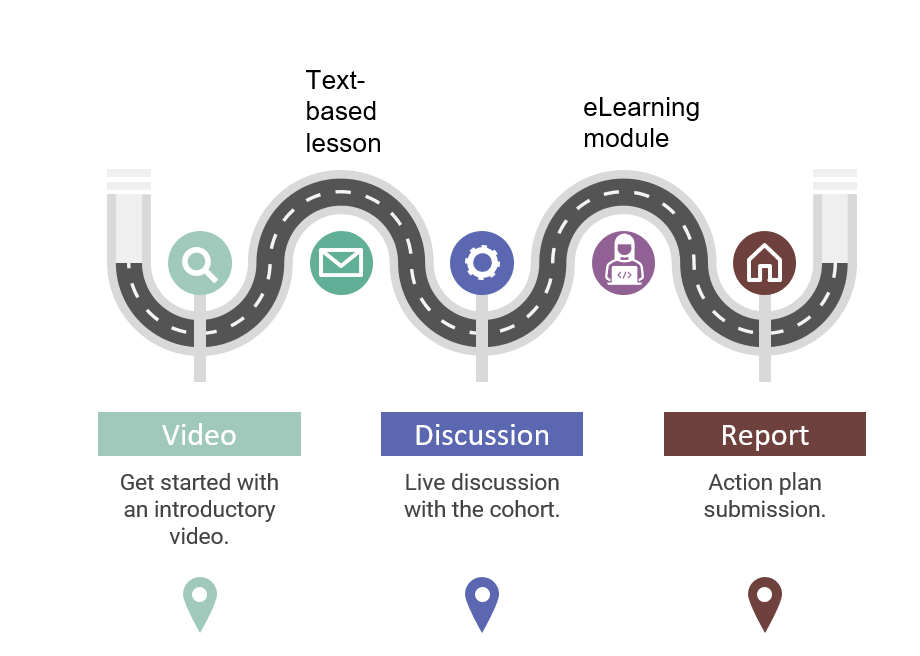TL: DR
Blended learning provides an opportunity to deliver MSL training with variety and flexibility.
Reskilling and upskilling are a huge issue in the corporate world, and Medical Affairs has always been under pressure to add to team skillsets continuously.

When Does Blended Learning Work
Blended learning programs work for all types of training needs.
In Medical Affairs departments, the format works well for:
- Onboarding
- Soft-skills training
- Continuous MSL education
- Technical training
- New Manager training
- HiPo Training
Updating from Live to Blended
Consider this situation.
An MSL training workshop usually runs for a full day, with travel required to the event.
The MSL loses productive time at each training opportunity.
Could the training be completed with the same (or better) outcomes using blended learning?

Yes. Time-short MSLs benefit from little bursts of training content delivered in various formats over days or weeks.
The spaced repetition is great for memory retention, MSLs can reflect and practice the content between training elements, and bandwidth remains high.

A blended program also increases the opportunity for interleaving formal and informal training elements.
Have you considered blended learning for your team?
Creating a Learning Journey
Trainers craft learning journeys in a blended approach to take advantage of the multiple modalities adults use to gain knowledge.
- Video
- Informal Discussion
- Reading
- Reflection
- Writing
- Practicing
- eLearning
- Virtual tours
- Exercises
- Podcasts
- Journaling

This list is not comprehensive – the possibilities are unlimited.
Given the overall learning goals and program objectives, training can last one week, multiple weeks, or even months.
One example would be to use blended learning to train the team on a new manuscript.

Week 1 could start with an introductory video to set up the study context and how the data supports or enhances what researchers already know. The PDF is also delivered.
Week 2 is a text-based lesson delivered to the MSL’s cell phone while working in the field.

Week 3 is a discussion of the main results and limitations of the study.
Week 4 provides the MSLs an opportunity to work through a few scenarios of integrating the new data into their scientific exchanges in the field.
At the end of that week, the MSLs submit an action plan for their territory regarding prioritizing conversations on the new data.

That is just one possibility!
MSL Feedback
MSLs find blended learning fits in with the way they do their job.
The individual elements fit together to support the learning opportunity.
Each element could be a stand-alone, but they fit together into a powerful way to engage MSLs.

Contact Us to Develop Your Strategy
If you would like to discuss your team’s situation, please get in touch with us.
We would be happy to discuss how a blended learning solution can support your team’s goals.
References
Bonk, Curtis J. The Handbook of Blended Learning: Global Perspectives, Local Designs, 1st Edition. 624 pages.
Bonk, C.J., Kim, K.J. & Zeng, T. (2005). Future Directions of Blended Learning in Higher Education and Workplace Learning Settings. In P. Kommers & G. Richards (Eds.), Proceedings of ED-MEDIA 2005–World Conference on Educational Multimedia, Hypermedia & Telecommunications (pp. 3644-3649). Montreal, Canada: Association for the Advancement of Computing in Education (AACE). Retrieved July 29, 2021 from https://www.learntechlib.org/primary/p/20646/.
Mansoori, S., Salari Koohfini, Z., Ghasemali, M. (2020). A Comparison Between the Effectiveness of E-learning and Blended Learning in Industrial Training. Interdisciplinary Journal of Virtual Learning in Medical Sciences, 11(1), 46-53. doi: 10.30476/ijvlms.2020.84352.1006

